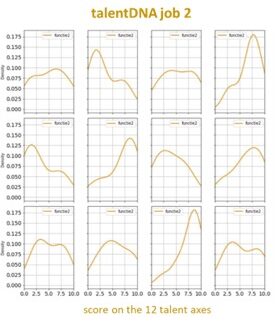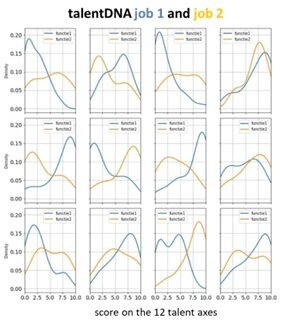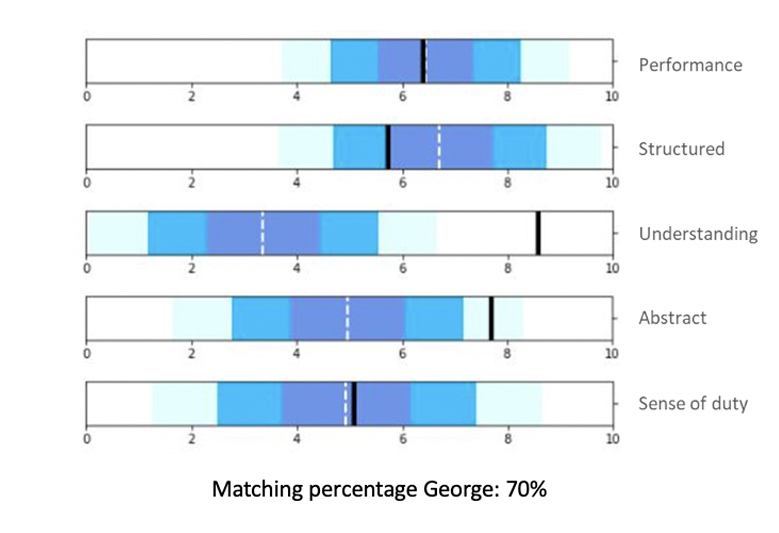The talentDNA of a job
The quality of a selection method is determined by the correlation between a candidate’s result on the selection test and the evaluation of how the candidate performs once hired.
In terms of task-performance, cognitive ability tests provide the highest validity. These tests appear to predict reasonably well whether a person has the right intelligence(s) to perform the required tasks.

Research (e.g. Schmidt and Hunter (1998)) shows that we have a much harder time predicting whether there will be a good match between the person and the job and between the person and the organization. Indeed, the validity of the selection methods used for this purpose (interviews/role-playing/…) are very dependent on a number of factors that are difficult to control (e.g. the expertise and experience of the selection officer).
What if we could determine the person-job match as well as person-organization match by an objective measurement of the characteristic talents corresponding to the job (the talentDNA of the job)?
After all, when we can determine the talentDNA of a job, we have the opportunity to test whether or not the candidate’s individual talent profile matches the job in a specific company. When there is a good match then we know that the candidate is cut from the right cloth.
How to determine a person’s talent profile?
Using the online questionnaire, The Talentpassport (www.mytalentpassport.com), the candidate determines his/her unique talent profile based on 20 emotional talents and 4 rational talents (12 talent axes system).
How to determine the talentDNA of a job?
Practical tests show that the talent scores of employees who are a good match for a job show a number of characteristic clusters (concentrations) of scores.
You map these clusters clearly by plotting the density curves of the talent scores in a graph. The higher the peak, the higher the concentration of scores at that location.
We call the score interval of a characteristic cluster a DNA zone.



The talentDNA of a job must, of course, be sufficiently distinct from the talentDNA of another job. In the graph below you see a combined graph of the talentDNA of job 1 (reception clerks) and job 2 (administrative clerks). You can see that for these two functions there are sometimes peaks in the density curves in the same place, but also peaks in completely different places.
How do you match a person’s talent profile with the talent DNA of a job?
As an example, let’s take a technical position in an installation company and a person « George ».
In the figure below you can see:
- the 5 characteristic talent clusters (DNA zones) of the function
- the talent scores of Joris in relation to these DNA zones
A matching algorithm calculates the degree to which George matches this job. Apart from George’s’ matching score, we see on the graph where exactly George has a good match and less good match with the job’s characteristic talents.

Legend
- zone with different shades of blue = DNA-zone
- vertical white dashed line = center of the DNA-zone
- vertical black line = George’s talent score
What of the importance of diversity in teams?
Diversity certainly adds value in a team. But not in the core of the job. At this technical job, the core of the job consists of 5 DNA zones. Diversity is very welcome in the many other talent axes, but diversity in the 5 talent axes of the core would lead to an unstable core. With a strong, stable core, this function can actually handle diversity and change more easily. Compare it to a spinning top. A spinning top that spins smoothly revolves around a stable core.
Additional benefits of matching on talents:
- The candidate’s talent profile describes his potential (future-oriented) rather than the degree of competence (past). This is becoming increasingly important in a rapidly changing world in which people increasingly need to retrain.
- Working with talents excludes possible discriminatory subjectivity towards certain groups (e.g. gender, origin, diploma, etc.) and thus promotes inclusiveness and diversity.
Author: Peter Monsieurs / The Talentpassport